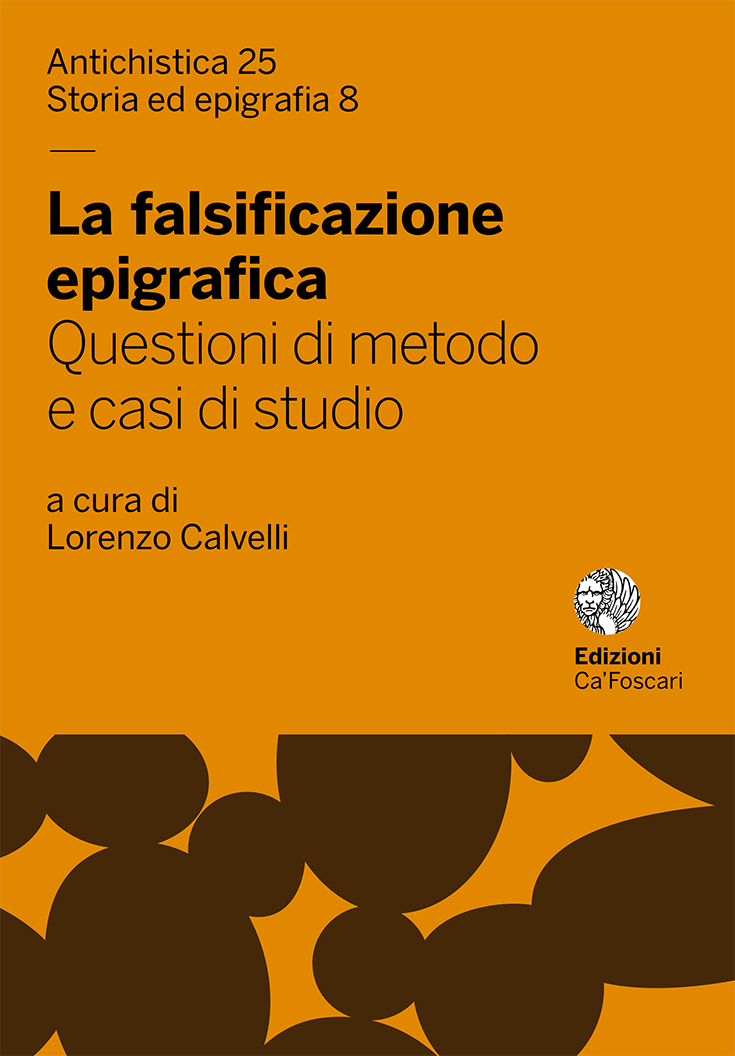Series |
Antiquity Studies
Volume 25 | Edited book | Epigraphic Falsification
Epigraphic Falsification
Methods and Case Studies
open access | peer reviewed-
edited by
- Lorenzo Calvelli - Università Ca’ Foscari Venezia, Italia - email orcid profile
Abstract
The book investigates the complex articulations of epigraphic forgery, a phenomenon widely attested in Italy between the late Middle Ages and the 18th century. Non-genuine inscriptions or falsae, as Theodor Mommsen called them, are those that present themselves as ancient, but in reality are not. They can be produced either on material support or simply on paper. Within them, different types of documents can be distinguished: forgeries made for malicious purposes, replicas of ancient inscriptions, and texts or monuments inspired by classical epigraphic models. The book brings together fifteen scholarly essays, which examine individual cases of forgery, reconstruct the epistemology of forgery criticism and rehabilitate numerous epigraphs mistakenly believed to be forgeries, while confirming their actual antiquity.
Keywords Digital editions • False inscriptions • Manuscripts • Spurious imitations • Epigraphic research • Council of Trent • Epitaph • Mariangelo Accursio • Thomas Hollis • Savoy Piedmont • Intellectual history • Latin poets of Renaissance • Classical scholarship • Epigraphic forgeries on paper • Aqua Vergine • Internet • Epigraphic forgeries • Ager Mediolanensis • Ancient restorations • Christian forgeries • Fake • Latin epigraphy • Roman Liguria • Antonio Trevisi • Epigraphy • Copies • Amphora • Non-alphabetic graphemes • F • Decretum Rubiconis • House of Savoy • Fitzwilliam Museum • Meyranesio • Epigraphic models • Fake inscriptions • Aquileia • Lucas Peto • Pingone • Coarse altar • Primacy of Sardinia • Forgeries • Inscribed zone as decorative surface • Manuscript • Casa Museo dell’Antiquariato Ivan Bruschi • Forged inscriptions • Lex de imperio Vespasiani Antonio Agustín • Marche • Luigi Biraghi • Theodor Mommsen • Spain • Epigraph balanced between dimensions and inscripti • Forged blunder • Antiquarian market in the early 1900s • Jacopo Valvasone • CIL VI 990* • Renaissance • Lepontic • Aqueducts • John Disney • Johns Hopkins Archaeological Museum • Pseudo-antique palaeography • Counterfeit instrumentum inscriptum • Forgery • Ciriaco de’ Pizzicolli • CIL VI 991* • G • Pirro Ligorio • Critical editions • Senatus consultum • Cities • Antiquarians • Printed editions • Documentary forgeries
Permalink http://doi.org/10.30687/978-88-6969-386-1 | e-ISBN 978-88-6969-386-1 | ISBN (PRINT) 978-88-6969-387-8 | Number of pages 312 | Dimensions 16x23cm | Published Dec. 16, 2019 | Language it, fr, en
Copyright © 2019 Lorenzo Calvelli. This is an open-access work distributed under the terms of the Creative Commons Attribution License (CC BY). The use, distribution or reproduction is permitted, provided that the original author(s) and the copyright owner(s) are credited and that the original publication is cited, in accordance with accepted academic practice. The license allows for commercial use. No use, distribution or reproduction is permitted which does not comply with these terms.
-
La ricerca sulla falsificazione epigrafica oggi
Dove siamo e dove andiamo - Dec. 16, 2019
- Monsignor Luigi Biraghi e i falsi di Cernusco
- Dec. 16, 2019
-
Vicende di un falso senatoconsulto
Il decretum Rubiconis fra Ciriaco de’ Pizzicolli, Antonio Agustín e Eugen Bormann - Dec. 16, 2019
- ‘Falsi’ epigrafici in Internet: una fenomenologia
- Dec. 16, 2019
-
Iscrizioni falsae nelle collezioni inglesi
Il caso del Fitzwilliam Museum di Cambridge - Dec. 16, 2019
-
La (cattiva) coscienza del falsario
Ricerca e produzione di iscrizioni latine in Sardegna fra XVI e XIX secolo - Dec. 16, 2019
-
Falsari piemontesi del XVI secolo
Monsù Pingon e gli altri - Dec. 16, 2019
-
Mariangelo Accursio and Pirro Ligorio
The Possible (and Interesting) Genesis of CIL VI 990* and CIL VI 991 - Dec. 16, 2019
- Per uno studio dei falsi nel manoscritto inglese di Jacopo Valvasone di Maniago (1499-1570)
- Dec. 16, 2019
- La città e i suoi falsi
- Dec. 16, 2019
-
I falsi epigrafici di Giuseppe Francesco Meyranesio
Ispirazioni e modelli - Dec. 16, 2019
-
Digitalizzazione e intelligenza del falso epigrafico
Il caso di un titulus atestino - Dec. 16, 2019
- Falso quando?
- Dec. 16, 2019
- Il falsario Sententiosus
- Dec. 16, 2019
